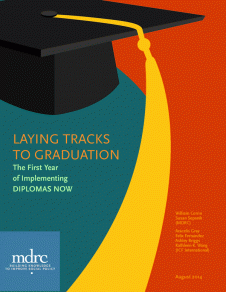Laying Tracks to Graduation
The First Year of Implementing Diplomas Now

Too many students in high-poverty, urban communities drop out of high school, and too few graduate prepared for college and careers. Three national organizations — Talent Development Secondary, City Year, and Communities In Schools — have formed Diplomas Now in an effort to transform urban secondary schools so fewer students drop out and more graduate ready for postsecondary education and work. Thanks to a validation grant from the U.S. Department of Education’s 2010 Investing in Innovation (i3) competition and matching funds from private sources, teams from all three organizations are implementing the Diplomas Now data-driven, tiered intervention model in schools across the nation. The model combines a comprehensive school reform strategy aimed at transforming the academic experience of all students with early warning indicators related to attendance, behavior, and course performance. Diplomas Now identifies students at risk of dropping out and intervenes with targeted support intended to get failing students back on track.
MDRC and ICF International are conducting an independent, experimental evaluation of the impact and implementation of Diplomas Now. During the 2011-2012 and 2012-2013 school years, 62 secondary schools in 11 school districts agreed to participate in this study. Thirty-two of these schools were randomly assigned to implement the Diplomas Now model while the other 30 schools were assigned to a “control group,” continuing their existing school programs or implementing other reform strategies of the districts’ or schools’ choosing. This report introduces Diplomas Now and the associated evaluation, describing the reform model, the research design, and the participating schools and districts. The report also shares first-year implementation fidelity findings, and discusses collaboration among the Diplomas Now partners and between those partners and schools.
- The 62 study schools represent the kinds of schools for which the Diplomas Now model was designed: schools serving students from low-income communities who face challenges inside and outside of school that put their progress to high school graduation at risk. Randomization resulted in two comparable groups of schools and will allow the evaluation team to assess the model’s impact on key predictors of graduation: attendance, behavior, and course performance.
- On average, implementation of the model got off to a good start in the 32 Diplomas Now schools in the first year. These schools were most successful in adapting a tiered intervention model and incorporating additional student support services like tutoring and after-school programs, but met with less success introducing new curricula and model-specific teacher professional development practices such as peer coaching.
- It is no small feat that three independent national organizations were able to come together and get this multifaceted, complex school reform model off the ground in the implementing schools. Not only did their staff members have to build relationships with one another, they had to collaborate with school personnel to begin changing structures and practices in the implementing schools. However, the roles and responsibilities of staff members from the Diplomas Now organizations were not always clear at the outset, which may have constrained early model implementation. As implementation continues, the Diplomas Now organizations continue to work with each other and schools in an effort to strengthen the cohesion and coordination of reform work by all stakeholders.







